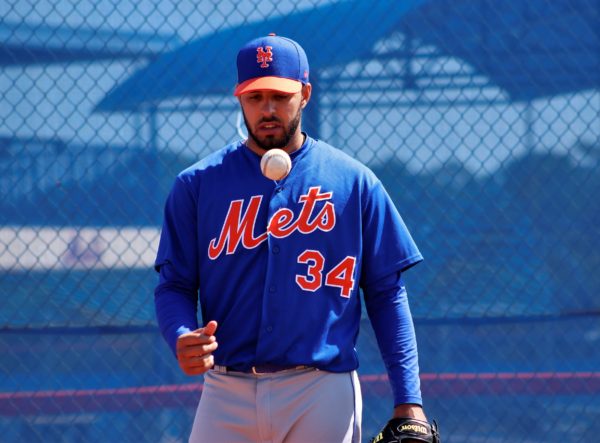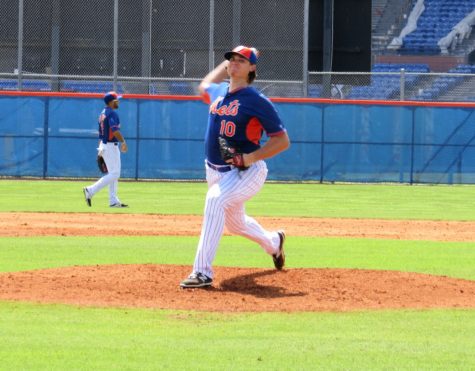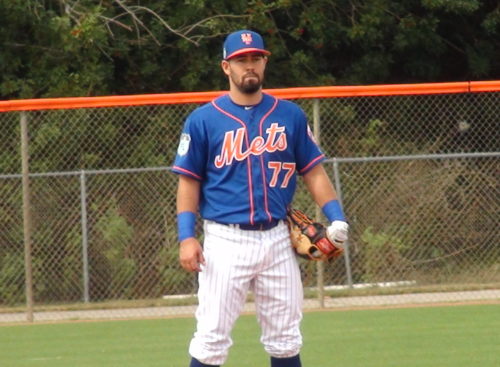
(Jacob Resnick/Mets Minors)
15. RHP Nabil Crismatt
Ht: 6’1″ Wt: 200 Level: St. Lucie
B/T: R/R Age: 12/25/1994 (22) Age Dif: -1.1
Acquired: Signed by the Mets as a non-drafted free agent on Aug. 3, 2011
Previous Rank: 26
2016 Statistics: 4-10, 3.62 ERA, 21 G, 20 GS, CG, 121.1 IP, 1.320 WHIP, 9.0 K/9
Profile: It has certainly been an interesting path for Crismatt to this point. He was a non-drafted free agent who spent four years in rookie ball, and he was mostly used as a reliever early in his career. With him continously improving, Crismatt eventually forced himself into the starting rotation not just for the New York Mets, but also his native Colombia in the World Baseball Classic. When he held his own against the vaunted Dominican Republic offense, you knew he was ready to take the next step.
Crismatt has continued to succeed as a pitcher because he goes out there and attacks batters. In addition to attacking batters, he keeps them off-balance by using a plus change-up he is willing to use in any count. As Crismatt told MMN in an exclusive interview, it is more about locating pitches than anything else:
“I am a humble and simple person. I am a world player and I enjoy sharing with all kind of people. As a pitcher I control every pitch of pitchers. I put the ball wherever place and whenever I desire. This game is about precision.”
The other thing that stands out with him is he leaves no stone unturned in trying to improve his game. He’s a baseball rat that not only works on his own game, but he also watches a lot of baseball to see what he can do to help improve his game. As a result, Crismatt has incorporated things like the quick pitch and some of the varying windups you’ll see from Johnny Cueto as he believes it helps him get batters out.
In the end, you have a pitcher who knows what he is and continues to do all he can do to improve. He maximizes his 88-92 MPH fastball by not only effectively locating the pitch, but by using his changeup. With that, there are still two things he needs to improve in order to take himself to the next level as a prospect.
First and foremost, he needs a strong third pitch. While Crismatt has gotten to this point by attacking batters and getting results, his lack of a third pitch will eventually force him back to the bullpen. The next hurdle is stamina. While he has the stamina to go deep into games, he have seen him tire recently. In the In May and June, Crismatt had a 1.51 ERA. In July, that has ballooned to 5.47. This is partially due to a high .468 BABIP, but that BABIP is fueled with Crismatt tiring as the season progresses. To that end, we have seen the Mets begin to ease up on how many pitches he is throwing per outing.
However, with this being Crismatt’s first full season as a starter in the minors, we should not read too much into that. Instead, we should focus on the continued strides he has made. Hopefully, next in line will be a reliable third pitch.

14. RHP Corey Oswalt
Ht: 6’5″ Wt: 245 2016 Level: Binghamton
B/T: R/R Age: 9/3/1993 (23) Age Dif: -1.4
Acquired: Seventh round of the 2012 Draft from James Madison HS in San Diego, Calif
Previous Rank: 43
2016 Statistics: 8-4, 2.43 ERA, 19 G, 19 GS, 103.2 IP, 1.196 WHIP, 7.5 K/9
Profile: Oswalt is a big guy who has been taking some big strides since the beginning of the 2016 season. He worked through some early struggles in the Sally League, and he wound up putting together a good season with the Mets sending him to the Arizona Fall League. Oswalt led the Scottsdale Scorpions pitchers in wins (4), tied for first in innings pitched (27), and second in strikeouts (21).
This year, Oswalt has picked up where he left off in Arizona with him not only being an Eastern League All Star, but he was also named the starting pitcher in the game. The reason why is Oswalt continues to do all the things he needs to do to develop as a pitcher. As he told MMN in an exclusive interview:
“For the most part, for me at least they’ve let me just kind of gradually develop, just mature. Commanding the strike zone, not walking guys, getting ahead, that kind of stuff. But other than that, go off of as I’ve gotten stronger and stuff, and learn how to pitch and know myself. But I think commanding the strike zone is a big part of the Mets’ (philosophy).”
He certainly has gotten stronger. When he was first drafted, Oswalt was touching the 90s, but now he is not routinely sitting in the low 90s. In fact, Oswalt has seen his fastball on occasion reach the mid-90s. He also has a slider and a changeup that have both seen incremental improvements over the years. As Oswalt noted above, he is able to perform well with these pitches because he is locating his pitches well.
The one real hiccup in Oswalt’s season is he had to spend time on the disabled list making this the third consecutive year he has found himself there. This time it was for a minor knee issue. The disabled list stint served him well as Oswalt has been terrific since activated. In his eight starts since being activated off the disabled list, he is 4-0 with a 1.38 ERA, 1.095 WHIP, and a 7.3 K/9. With him pitching like this, he may well find himself in Las Vegas sooner rather than later.

Photo By Ernest Dove
13. MI Luis Guillorme
Ht: 5’9″ Wt: 190 Level: Binghamton
B/T: L/R Age: 9/27/1994 (22) Age Dif: -2.2
Acquired: Selected by Mets in 10th round of the 2013 Draft from Coral Springs (Fla.) Charter High School.
Previous Rank: 27
2017 Stats: 100 G, 438 PA, 383 AB, 55 R, 112 AB, 16 2B, HR, 33 RBI, 4 SB, CS, .292/.374/.342
Profile: Even before Spring Training, Guillorme was praised for his accurate arm, speed, and soft hands. It’s just that most people didn’t know about him until he caught a flying bat heading into the dugout in Spring Training.
Since that time, we have seen a number of highlights from Guillorme during the 2017 season with him twice winning the MiLB Defensive Play of the Week. However, Guillorme is more than just flash in the field. He is a very good middle infielder capable of playing excellent defense at both second and shortstop. That is a process that started for Guillorme as a young child. As Guillorme’s father, Luis, Sr., told MMN’s Mets Daddy:
“[Luis] repeated the motions (Omar Vizquel’s) time and time again until he was able to do it perfectly. That was the easy to manage, the most difficult part was tolerating the sound of the baseball hitting the walls, inside our house hundreds of times on a daily basis, because in our neighborhood it wasn’t safe for him to play out on the street. He was always practicing and playing inside the house.
Every single day he spent hours throwing baseballs, tennis balls or rubber balls against the wall and then trying to catch them before they touched the floor or before they passed him. He has always been full of energy, sending him to bed was a titanic duty, and sometimes it still is [laughs]. I think his reflexes and quickness escalated to a higher level by doing that. It is funny now, but sometimes it was exhausting.”
With Guillorme, the question was never his defense, it was his offense. With his incredible defense, he doesn’t need to hit much to get onto the field whether that be as an everyday player or a defensive specialist. This year, Guillorme has once again made strides on that front. A major reason why is Guillorme knows who he is at the plate.
Guillorme is a contact hitter who uses the whole field. He has a good working knowledge of the strike zone, and he has continued to refine his approach at the plate. While he has had typically good walk rates in his minor league career, his 11.4% is a career best and a continued step in right direction. Another positive step is Guillorme has seen his strikeout rate drop for a third straight season, and it is now at an excellent 1o.5%. Put another way, Guillorme is now striking out as frequently as he walks. No matter what type of hitter you are, that’s great. When you’re a hitter who has little power, it’s absolutely crucial.
His continued development at both sides of the ball is why Guillorme was the starting second baseman in the Eastern League All Start Game, and it is a reason to continue to keep an eye on him. The results are even more impressive when you consider how young he is for his level.

Photo by Ed Delany
12. C Tomas Nido
Ht: 6’0” Wt: 200 2016 Level: Binghamton
B/T: R/R Age: 4/12/94 (23) Age Dif: -1.2
Acquired: Drafted 8th round in 2012 out of Orangewood Christian School, FL
Previous Rank: 10
2017 Stats: 80 G, 318 PA, 290 AB, 33 R, 70 H, 17 2B, 3B, 6 HR, 48 RBI, .241/.289/.369
Profile: After a breakout season last year in the Florida State League, Nido was added to the Mets 40 man roster, and he positioned himself as the Mets proverbial catcher of the future. His standing as the Mets catcher is not as clear after the first four months of the 2017 season.
Now, we have seen some glimpses. In the Month of May, Nido hit .313/.367/.475 with seven doubles, two homers, and 15 RBI. This month led you to believe Nido’s tough April was related more to him adapting to a higher level. However, as the season has progressed the questions about Nido offensively have begun to re-emerge.
Digging deeper into those May numbers, Nido had a .329 BABIP, which is a higher than usual number. Looking at last year, Nid0 had a .344 BABIP. That high BABIP was certainly a part of the reason why Nido had a breakout season at the plate last year. Overall, these numbers should at least cause you to question what Nido is as a hitter.
The answer to that question is Nido is a contact hitter who is still progressing. Putting BABIP aside, we see a hitter who has low walk (6.9%) and strike out rates (12.3%). This is really a result of him being aggressive at the plate, and his willingness to go outside the zone. With him being so aggressive both in and sometimes out of the zone, Nido is going to see the wild BABIP fluctuations we have seen from him. That’s a large reason why Nido went from a .329 BABIP in May to a .237 BABIP later.
Before fully assessing him as a hitter, consider that .237 BABIP is as unsustainably low over the course of a career as a .344 BABIP is, at least for someone like Nido who has a good line drive swing with some pop. To that end, the catching position is a grueling position, and over the course of the 162 game season, a catcher is going to wear down. Ultimately, this means until Nido refines his approach, there is real reason to question his bat.
Conversely, what you can trust is his skills behind the plate. He is well regarded as a receiver who works well with his pitching staff. He also controls the running game throwing out 42% of base stealers last year and 44% this year.
Overall, between his defense and his still being just 23, there are reasons to still believe Nido will continue to improve his game. However, in order for him to reach the next level, he is going to have to refine his approach at the plate.

(Jacob Resnick/Mets Minors)
11. CF Desmond Lindsay
Ht: 6’0″ Wt: 200 Level: Columbia
B/T: R/R Age: 1/15/1997 (19) Age Dif: -2.1
Acquired: Selected in the second round (53 overall) of the Amateur Draft (Out-of-Door Academy, Sarasota, Fl.)
Previous Rank: 5
2016 Statistics: 37 G, 122 AB, 21 R, 37 H, 6 2B, 4 HR, 17 RBI, 26 BB, 31 K, 3 SB, .303/.433 /.451
Profile: Likely, this analysis and position on the prospect ranks would have been much different if not for the various injury issues he has had not just this year but in his career as a whole.
One of the reasons Lindsay had even fallen to the second round was because he had leg issues in high school. Those issues have re-appeared in the minors with him starting the year on the disabled list as a result of them. Now, those leg issues are on the back-burner because Lindsay had season ending ulnar nerve transposition surgery.
Hopefully, this is a temporary set-back for him. Certainly, it is encouraging he is expected to be ready for Spring Training. It should also be noted Albert Pujols once had the same surgery in 2007. He responded by winning his second MVP award and fourth Silver Slugger in 2008. Therefore, it is not only possible to return from this surgery, it is also possible to improve as a player after having had the surgery. The major caveat here is no one quite knows the full extent of the damage to Lindsay’s ulnar nerve. Without that information, there needs to at least be a pause when it comes to whether or not he will ever reach his ceiling.
That ceiling is quite high as Lindsay has a desirable combination of plus speed, plus raw power, and a plus arm. In sum, this is a guy who can be a five tool player. The real shame of it is we started to see that player emerge this season for the Columbia Fireflies.
After a slow start which was partially due to a combination of coming back from injury and adjusting to a new league, Lindsay took off. Since June 1st, the player once dubbed an “offensive machine” hit .322/.372/.575 with five doubles, one triple, five homers, and 16 RBI in 23 games. In the field, he posted a range factor of 2.44 per nine innings in center field. This is not too far off from the 2.54 range factor per nine innings we have seen from Gold Glover Juan Lagares in center field this year.
Overall, we once again got a taste of what Lindsay’s ceiling looks like. It’s perhaps higher than anyone else in the Mets minor league system. Unfortunately, with his inability to stay on the field, it becomes increasingly more questionable whether he will ever hit that ceiling. Still, this is an extraordinarily talented player who is this close to busting out.
EDITOR’S NOTE: These rankings have been updated to reflect changes that have occurred in the Mets minor league system since the trade deadline.
PREVIOUS RANKINGS:


Lindsay is top 5 talent…
So Anthony Kay doesn’t make the Mets top 40???
Academy183s
It’s really just based on his injury history. If he was healthy all season, even with the down year in average he was having a good season defensively, showed his pop & good eye at the plate. Him healthy all season he will be Top 3 next season with Gimenez. Would love to see Lindsay healthy next season and move up the ranks.
We left him off with the combination of not having pitched and being injured, he would be in the top 40.
Earth281s